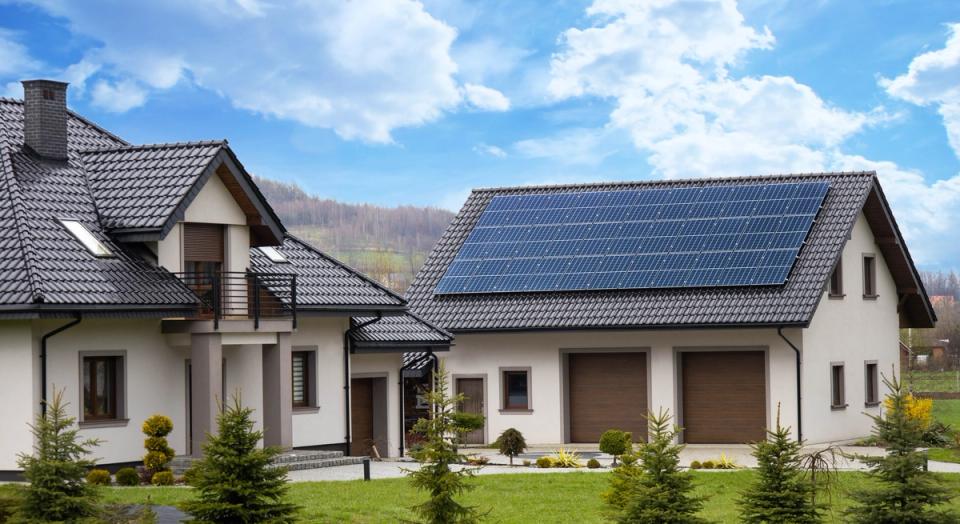
As energy costs rise and environmental concerns grow, many homeowners are considering solar roofing as a way to increase energy efficiency and reduce utility bills. Solar roofing provides a renewable energy solution that can also enhance property value over time. However, the decision to install solar roofing requires careful evaluation of costs, benefits, and long-term impact. This guide will help homeowners determine whether solar roofing is the right choice for their property.
Understanding Solar Roofing
Solar roofing integrates photovoltaic (PV) technology into roofing materials, allowing homeowners to generate electricity from sunlight. There are two primary types of solar roofing:
- Solar Panels: Traditional PV panels mounted on top of an existing roof.
- Solar Shingles: Solar cells embedded directly into roofing materials for a seamless appearance.
Both options offer energy production benefits but vary in cost, efficiency, and aesthetics. While solar panels typically offer higher efficiency, solar shingles provide a more visually appealing solution for homeowners concerned with aesthetics.
Benefits of Solar Roofing
Energy Savings
One of the biggest advantages of solar roofing is the potential reduction in energy bills. By generating electricity from the sun, homeowners can offset their reliance on grid power, leading to significant savings over time. Depending on local electricity rates and energy consumption, solar roofing can drastically cut monthly utility costs.
Environmental Impact
Utilizing solar energy helps lower carbon emissions, contributing to a cleaner environment. By switching to solar roofing, homeowners can decrease their environmental footprint and contribute to a more sustainable future. Additionally, reducing reliance on fossil fuels can lessen the impact of fluctuating energy prices and supply chain issues.
Increased Home Value
Properties equipped with solar roofing may attract buyers due to potential energy savings and sustainability benefits. Potential buyers see solar power as a valuable investment that provides long-term energy savings and reduces dependence on traditional electricity sources. Studies suggest that homes with solar installations tend to sell faster and at a higher price than those without.
Tax Incentives and Rebates
Governments and local utilities often offer tax credits, rebates, and incentives for solar installations. These financial benefits can significantly reduce the initial cost of installation and improve the return on investment. Homeowners should research available programs in their area to maximize potential savings.
Durability and Longevity
Solar shingles and panels are designed to withstand harsh weather conditions, making them a durable addition to a home. Many solar roofing options come with warranties ranging from 20 to 30 years, ensuring long-term performance. Additionally, solar panels can help protect roofing materials by acting as a barrier against UV rays and severe weather.
Factors to Consider Before Installing Solar Roofing
Upfront Costs
Solar roofing installation requires a significant initial investment. While tax incentives and energy savings can offset the cost over time, homeowners must be prepared for the upfront expense. The total cost varies based on system size, roof type, and local installation rates.
Roof Condition and Suitability
A roof should be in good condition before installing solar roofing. If a roof is old or in need of repair, it may require replacement before solar panels or shingles can be added. Structural integrity is crucial to support the additional weight of solar equipment.
Energy Needs and Sunlight Exposure
Homes in areas with ample sunlight will benefit the most from solar roofing. Shaded properties or those with minimal sun exposure may not generate enough energy to justify the investment. Homeowners should evaluate their roof’s orientation, shading from trees or buildings, and local climate conditions before making a decision.
Maintenance and Repairs
While solar roofing is relatively low-maintenance, occasional cleaning and inspections are necessary to ensure peak performance. Dust, debris, or snow accumulation can reduce efficiency, requiring periodic upkeep. Homeowners should also confirm warranty coverage for repairs and replacements.
Solar Roofing vs. Traditional Roofing with Solar Panels
Homeowners must choose between integrating solar shingles or installing traditional solar panels over an existing roof. Each option has distinct advantages:
- Solar Shingles: Provide a sleek, integrated look but may be less efficient than traditional panels. They are best suited for new roofing projects or full roof replacements.
- Solar Panels: Offer higher efficiency but are more noticeable and may not blend seamlessly with the roof. They are an excellent choice for homeowners looking to retrofit their existing roof with solar power.
Installation Process and Timeline
The solar roofing installation process typically involves:
- Site Assessment: A professional evaluates the roof's condition, energy needs, and suitability for solar power.
- Permitting and Approval: Homeowners must obtain necessary permits and approvals from local authorities, which may take a few weeks.
- Installation: The installation process can take anywhere from a few days to several weeks, depending on the system size and complexity.
- Inspection and Activation: Once installed, the system must be inspected before it is connected to the power grid and activated. Some utility companies may require additional approvals before allowing grid-tied connections.
Choosing a Solar Roofing Contractor
Selecting the right contractor is crucial for a successful installation. Homeowners should:
- Verify licensing, certifications, and experience.
- Request multiple quotes and compare pricing.
- Ask about warranties and maintenance services.
- Read customer reviews and check references.
- Ensure the contractor is familiar with local regulations and permitting requirements.
Conclusion: Is Solar Roofing Right for You?
Investing in solar roofing offers long-term advantages, including reduced utility costs, a smaller carbon footprint, and potential property value appreciation. However, factors such as cost, roof condition, and location must be carefully considered before making a decision. Homeowners should conduct thorough research, consult with professionals, and explore financial incentives to determine whether solar roofing is the best choice for their needs and budget. By making an informed decision, homeowners can enhance their property’s energy efficiency while contributing to a more sustainable future.